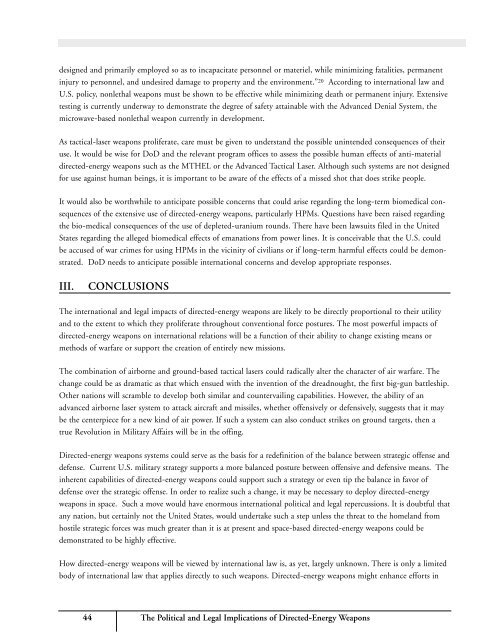directed-energy-weapons
directed-energy-weapons
directed-energy-weapons
Create successful ePaper yourself
Turn your PDF publications into a flip-book with our unique Google optimized e-Paper software.
designed and primarily employed so as to incapacitate personnel or materiel, while minimizing fatalities, permanentinjury to personnel, and undesired damage to property and the environment.” 20 According to international law andU.S. policy, nonlethal <strong>weapons</strong> must be shown to be effective while minimizing death or permanent injury. Extensivetesting is currently underway to demonstrate the degree of safety attainable with the Advanced Denial System, themicrowave-based nonlethal weapon currently in development.As tactical-laser <strong>weapons</strong> proliferate, care must be given to understand the possible unintended consequences of theiruse. It would be wise for DoD and the relevant program offices to assess the possible human effects of anti-material<strong>directed</strong>-<strong>energy</strong> <strong>weapons</strong> such as the MTHEL or the Advanced Tactical Laser. Although such systems are not designedfor use against human beings, it is important to be aware of the effects of a missed shot that does strike people.It would also be worthwhile to anticipate possible concerns that could arise regarding the long-term biomedical consequencesof the extensive use of <strong>directed</strong>-<strong>energy</strong> <strong>weapons</strong>, particularly HPMs. Questions have been raised regardingthe bio-medical consequences of the use of depleted-uranium rounds. There have been lawsuits filed in the UnitedStates regarding the alleged biomedical effects of emanations from power lines. It is conceivable that the U.S. couldbe accused of war crimes for using HPMs in the vicinity of civilians or if long-term harmful effects could be demonstrated.DoD needs to anticipate possible international concerns and develop appropriate responses.III.CONCLUSIONSThe international and legal impacts of <strong>directed</strong>-<strong>energy</strong> <strong>weapons</strong> are likely to be directly proportional to their utilityand to the extent to which they proliferate throughout conventional force postures. The most powerful impacts of<strong>directed</strong>-<strong>energy</strong> <strong>weapons</strong> on international relations will be a function of their ability to change existing means ormethods of warfare or support the creation of entirely new missions.The combination of airborne and ground-based tactical lasers could radically alter the character of air warfare. Thechange could be as dramatic as that which ensued with the invention of the dreadnought, the first big-gun battleship.Other nations will scramble to develop both similar and countervailing capabilities. However, the ability of anadvanced airborne laser system to attack aircraft and missiles, whether offensively or defensively, suggests that it maybe the centerpiece for a new kind of air power. If such a system can also conduct strikes on ground targets, then atrue Revolution in Military Affairs will be in the offing.Directed-<strong>energy</strong> <strong>weapons</strong> systems could serve as the basis for a redefinition of the balance between strategic offense anddefense. Current U.S. military strategy supports a more balanced posture between offensive and defensive means. Theinherent capabilities of <strong>directed</strong>-<strong>energy</strong> <strong>weapons</strong> could support such a strategy or even tip the balance in favor ofdefense over the strategic offense. In order to realize such a change, it may be necessary to deploy <strong>directed</strong>-<strong>energy</strong><strong>weapons</strong> in space. Such a move would have enormous international political and legal repercussions. It is doubtful thatany nation, but certainly not the United States, would undertake such a step unless the threat to the homeland fromhostile strategic forces was much greater than it is at present and space-based <strong>directed</strong>-<strong>energy</strong> <strong>weapons</strong> could bedemonstrated to be highly effective.How <strong>directed</strong>-<strong>energy</strong> <strong>weapons</strong> will be viewed by international law is, as yet, largely unknown. There is only a limitedbody of international law that applies directly to such <strong>weapons</strong>. Directed-<strong>energy</strong> <strong>weapons</strong> might enhance efforts in44 The Political and Legal Implications of Directed-Energy Weapons


